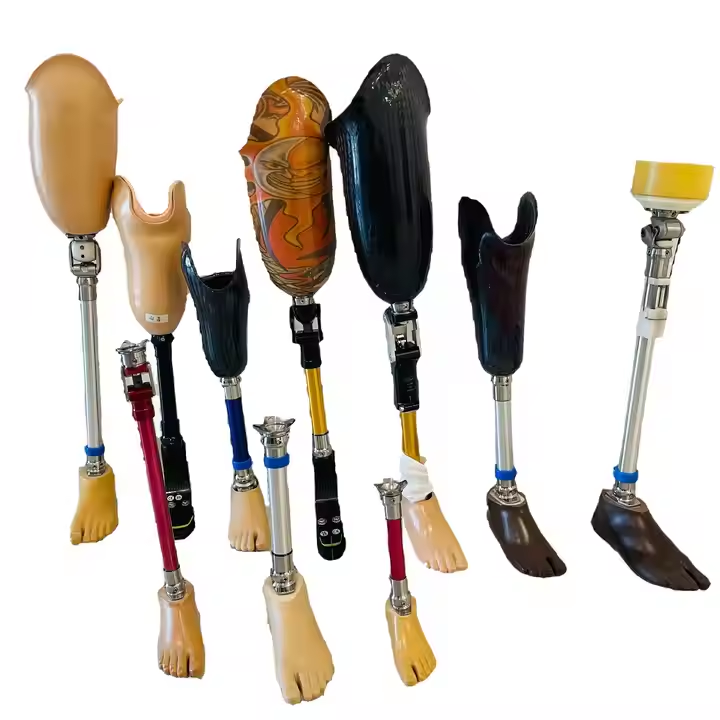Innovative Prosthetics and Orthopaedic Materials for Enhanced Comfort
Release Time:
Feb 08,2024
Table of Contents: 1. Introduction 2. Understanding Prosthetics and Orthopaedic Materials 3. Carbon Fiber Composites: Lightweight and Durable Solutions 4. Silicone: Flexible and Comfortable Prosthetic Covers 5. Titanium: The Strength and Biocompatibility Blend 6. 3D Printing: Customization and Precision 7. Smart Materials: Integrating Technology into Prosthetics 8. Artificial Intelligence and Robo
Table of Contents:
1. Introduction
2. Understanding Prosthetics and Orthopaedic Materials
3. Carbon Fiber Composites: Lightweight and Durable Solutions
4. Silicone: Flexible and Comfortable Prosthetic Covers
5. Titanium: The Strength and Biocompatibility Blend
6. 3D Printing: Customization and Precision
7. Smart Materials: Integrating Technology into Prosthetics
8. Artificial Intelligence and Robotics in Orthopaedic Devices
9. FAQs (Frequently Asked Questions)
10. Conclusion
1. Introduction
In this age of technological advancements, the field of prosthetics and orthopaedics has witnessed remarkable innovations that offer enhanced comfort, functionality, and aesthetics for individuals with limb loss or orthopaedic conditions. With the integration of cutting-edge materials and advanced manufacturing techniques, prosthetic limbs and orthopaedic devices have become more efficient, lightweight, and customizable than ever before. In this article, we explore the remarkable advancements in prosthetic and orthopaedic materials that are redefining the industry and providing a new level of comfort to patients worldwide.
2. Understanding Prosthetics and Orthopaedic Materials
Prosthetics are artificial limbs or body parts designed to replace missing or amputated limbs, while orthopaedic devices are medical devices used to support, align, or correct musculoskeletal conditions. The materials used in the construction of these devices play a crucial role in their overall performance, comfort, and durability. Traditional materials such as wood and metal have given way to more advanced materials that offer numerous benefits to both patients and healthcare professionals.
3. Carbon Fiber Composites: Lightweight and Durable Solutions
Carbon fiber composites have emerged as a game-changer in the field of prosthetics and orthopaedic materials. These materials offer a unique combination of strength, durability, and lightweight properties. Carbon fiber prosthetic limbs provide patients with improved mobility, reduced fatigue, and enhanced comfort. Additionally, carbon fiber materials allow for greater flexibility in design, enabling the creation of more anatomically accurate and aesthetically pleasing prosthetics.
4. Silicone: Flexible and Comfortable Prosthetic Covers
Silicone, a versatile material known for its flexibility and durability, is commonly used for creating prosthetic covers. These covers not only mimic the appearance of natural limbs but also provide a soft and comfortable interface between the prosthetic limb and the user's residual limb. Silicone covers are easily customizable, allowing for precise color matching and texture replication, resulting in a more natural and aesthetically pleasing appearance.
5. Titanium: The Strength and Biocompatibility Blend
Titanium is a lightweight and biocompatible material commonly used in orthopaedic implants and prosthetics. Its unique combination of strength and biocompatibility makes it an ideal choice for applications where durability and compatibility with the human body are paramount. Titanium implants offer enhanced osseointegration, reducing the risk of complications and improving overall patient satisfaction.
6. 3D Printing: Customization and Precision
The advent of 3D printing technology has revolutionized the prosthetics and orthopaedic industry. With 3D printing, prosthetic limbs and orthopaedic devices can be custom-designed and manufactured based on the patient's unique anatomical characteristics. This customization ensures a perfect fit, improved functionality, and enhanced comfort for the user. Furthermore, 3D printing allows for the creation of intricate and complex structures that were previously challenging to produce using traditional manufacturing methods.
7. Smart Materials: Integrating Technology into Prosthetics
Smart materials, also known as shape-memory materials, possess the ability to change shape or properties in response to external stimuli such as temperature, light, or moisture. These materials are being increasingly integrated into prosthetics to enhance functionality and improve user experience. For example, smart materials can enable prosthetic limbs to adjust their stiffness or flexibility based on the user's gait, providing a more natural and adaptive walking experience.
8. Artificial Intelligence and Robotics in Orthopaedic Devices
Artificial intelligence (AI) and robotics have found their way into orthopaedic devices, opening up new possibilities for enhanced comfort and functionality. AI algorithms can analyze patient data and adjust orthopaedic devices in real-time, optimizing their performance and providing personalized support. Robotic exoskeletons assist individuals with mobility impairments, allowing them to regain independence and perform daily tasks with ease.
9. FAQs (Frequently Asked Questions)
Q1: Can prosthetic limbs be customized for specific activities?
Q2: Are carbon fiber prosthetic limbs more expensive than traditional materials?
Q3: How long do prosthetic covers made from silicone last?
Q4: Are there any risks associated with titanium implants?
Q5: Can 3D-printed prosthetics be as durable as traditionally manufactured ones?
10. Conclusion
The advancements in prosthetic and orthopaedic materials are transforming the lives of individuals with limb loss or orthopaedic conditions. From carbon fiber composites to 3D printing and smart materials, these innovations have significantly improved comfort, functionality, and aesthetics. By embracing the potential of artificial intelligence and robotics, the field of prosthetics and orthopaedics is continuously pushing the boundaries of what is possible. As technology continues to evolve, we can expect even more innovative solutions that enhance the quality of life for individuals around the world.
1. Introduction
2. Understanding Prosthetics and Orthopaedic Materials
3. Carbon Fiber Composites: Lightweight and Durable Solutions
4. Silicone: Flexible and Comfortable Prosthetic Covers
5. Titanium: The Strength and Biocompatibility Blend
6. 3D Printing: Customization and Precision
7. Smart Materials: Integrating Technology into Prosthetics
8. Artificial Intelligence and Robotics in Orthopaedic Devices
9. FAQs (Frequently Asked Questions)
10. Conclusion
1. Introduction
In this age of technological advancements, the field of prosthetics and orthopaedics has witnessed remarkable innovations that offer enhanced comfort, functionality, and aesthetics for individuals with limb loss or orthopaedic conditions. With the integration of cutting-edge materials and advanced manufacturing techniques, prosthetic limbs and orthopaedic devices have become more efficient, lightweight, and customizable than ever before. In this article, we explore the remarkable advancements in prosthetic and orthopaedic materials that are redefining the industry and providing a new level of comfort to patients worldwide.
2. Understanding Prosthetics and Orthopaedic Materials
Prosthetics are artificial limbs or body parts designed to replace missing or amputated limbs, while orthopaedic devices are medical devices used to support, align, or correct musculoskeletal conditions. The materials used in the construction of these devices play a crucial role in their overall performance, comfort, and durability. Traditional materials such as wood and metal have given way to more advanced materials that offer numerous benefits to both patients and healthcare professionals.
3. Carbon Fiber Composites: Lightweight and Durable Solutions
Carbon fiber composites have emerged as a game-changer in the field of prosthetics and orthopaedic materials. These materials offer a unique combination of strength, durability, and lightweight properties. Carbon fiber prosthetic limbs provide patients with improved mobility, reduced fatigue, and enhanced comfort. Additionally, carbon fiber materials allow for greater flexibility in design, enabling the creation of more anatomically accurate and aesthetically pleasing prosthetics.
4. Silicone: Flexible and Comfortable Prosthetic Covers
Silicone, a versatile material known for its flexibility and durability, is commonly used for creating prosthetic covers. These covers not only mimic the appearance of natural limbs but also provide a soft and comfortable interface between the prosthetic limb and the user's residual limb. Silicone covers are easily customizable, allowing for precise color matching and texture replication, resulting in a more natural and aesthetically pleasing appearance.
5. Titanium: The Strength and Biocompatibility Blend
Titanium is a lightweight and biocompatible material commonly used in orthopaedic implants and prosthetics. Its unique combination of strength and biocompatibility makes it an ideal choice for applications where durability and compatibility with the human body are paramount. Titanium implants offer enhanced osseointegration, reducing the risk of complications and improving overall patient satisfaction.
6. 3D Printing: Customization and Precision
The advent of 3D printing technology has revolutionized the prosthetics and orthopaedic industry. With 3D printing, prosthetic limbs and orthopaedic devices can be custom-designed and manufactured based on the patient's unique anatomical characteristics. This customization ensures a perfect fit, improved functionality, and enhanced comfort for the user. Furthermore, 3D printing allows for the creation of intricate and complex structures that were previously challenging to produce using traditional manufacturing methods.
7. Smart Materials: Integrating Technology into Prosthetics
Smart materials, also known as shape-memory materials, possess the ability to change shape or properties in response to external stimuli such as temperature, light, or moisture. These materials are being increasingly integrated into prosthetics to enhance functionality and improve user experience. For example, smart materials can enable prosthetic limbs to adjust their stiffness or flexibility based on the user's gait, providing a more natural and adaptive walking experience.
8. Artificial Intelligence and Robotics in Orthopaedic Devices
Artificial intelligence (AI) and robotics have found their way into orthopaedic devices, opening up new possibilities for enhanced comfort and functionality. AI algorithms can analyze patient data and adjust orthopaedic devices in real-time, optimizing their performance and providing personalized support. Robotic exoskeletons assist individuals with mobility impairments, allowing them to regain independence and perform daily tasks with ease.
9. FAQs (Frequently Asked Questions)
Q1: Can prosthetic limbs be customized for specific activities?
Q2: Are carbon fiber prosthetic limbs more expensive than traditional materials?
Q3: How long do prosthetic covers made from silicone last?
Q4: Are there any risks associated with titanium implants?
Q5: Can 3D-printed prosthetics be as durable as traditionally manufactured ones?
10. Conclusion
The advancements in prosthetic and orthopaedic materials are transforming the lives of individuals with limb loss or orthopaedic conditions. From carbon fiber composites to 3D printing and smart materials, these innovations have significantly improved comfort, functionality, and aesthetics. By embracing the potential of artificial intelligence and robotics, the field of prosthetics and orthopaedics is continuously pushing the boundaries of what is possible. As technology continues to evolve, we can expect even more innovative solutions that enhance the quality of life for individuals around the world.
Keywords:
You Can Also Learn More About Industry Trends






